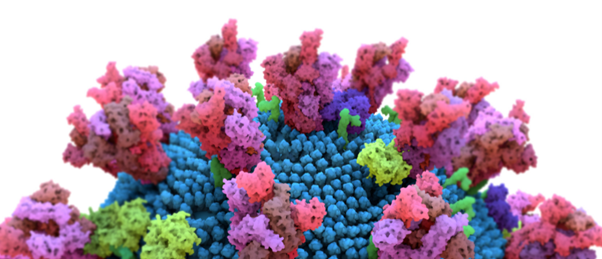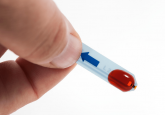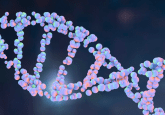Cryo-EM analysis reveals Omicron’s strong bond with human cells

The first molecular-level analysis of Omicron’s spike protein reveals mutation-induced chemical bonds are behind the new SARS-CoV-2 variant’s increased transmissibility and antibody evasion.
Researchers from the University of British Columbia (Vancouver, Canada) are the first to conduct a molecular-level structural analysis of the SARS-CoV-2 Omicron variant’s spike protein in complex with the ACE2 human cell receptor. The study, led by Dhiraj Mannar, identified the structural changes on the spike protein that are responsible for the increased transmissibility and immune evasion seen in the new variant. The team hope that the findings will support future work into developing variant-resistant treatments to COVID-19.
SARS-CoV-2’s spike protein binds with ACE2, allowing the virus to gain entry to human cells and cause infection. “Understanding the molecular structure of the viral spike protein is important as it will allow us to develop more effective treatments against Omicron and related variants in the future,” explained author Sriram Subramaniam. “By analyzing the mechanisms by which the virus infects human cells, we can develop better treatments that disrupt that process and neutralize the virus.”
The team analyzed the Omicron spike protein using cryo-electron microscopy to visualize its structure at near atomic resolution, revealing that the Omicron spike protein has a staggering 37 mutations – three– to five– times more than previous variants.
 Benefit of breastmilk: COVID-19 antibodies pass from vaccinated mothers to infants
Benefit of breastmilk: COVID-19 antibodies pass from vaccinated mothers to infants
Study detects neutralizing antibodies against SARS-CoV-2 in stool samples of infants breastfed by vaccinated mothers, which could provide passive immunity.
Three of these mutations – R493, S496 and R498 – were found to create new salt bridges and hydrogen bonds between the spike protein and the ACE2 receptor, allowing Omicron to bind more strongly to the human cell (also known as increased binding affinity). “It is remarkable that the Omicron variant evolved to retain its ability to bind with human cells despite such extensive mutations,” Subramaniam commented.
The team then investigated how these mutations affect the ability of antibodies to neutralize Omicron. Using a panel of six neutralizing monoclonal antibodies, they demonstrated that Omicron completely evaded five of the six antibodies and showed measurable evasion from the final one. Comparison of Omicron evasion from antibodies that were derived from people who had received two doses of a COVID-19 vaccine and had no prior history of COVID-19 infection, against serum samples from unvaccinated individuals who had recovered from infection by Alpha, Gamma or Delta variants also demonstrated increased evasion.
“Notably, Omicron was less evasive of the immunity created by vaccines, compared to immunity from natural infection in unvaccinated patients. This suggests that vaccination remains our best defense,” stated Subramaniam. “An important focus for our team is to better understand the binding of neutralizing antibodies and treatments that will be effective across the entire range of variants, and how those can be used to develop variant-resistant treatments.”
The group’s findings on the contribution of spike protein mutations to Omicron’s increased transmissibility provide a platform for improving current vaccines to protect against future SARS-CoV-2 variants.





